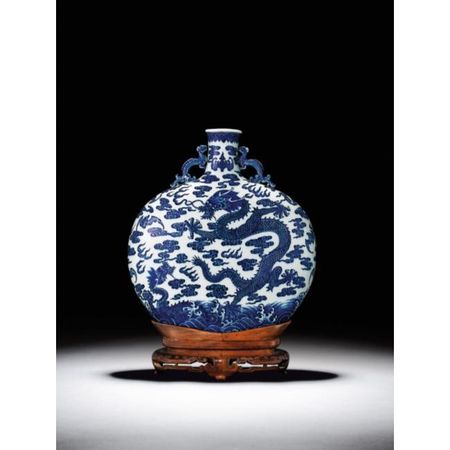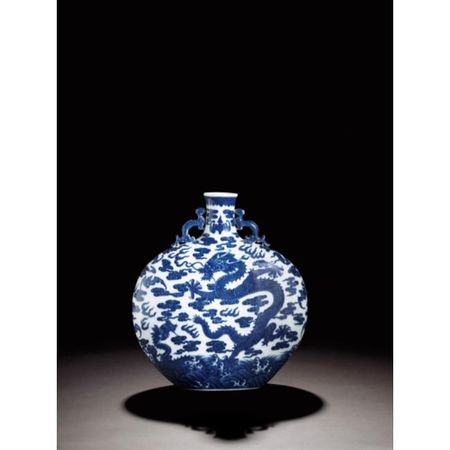Flasque en porcelaine bleu blanc, "bianhu", à décor de dragons. Chine, dynastie Qing, marque et époque Qianlong
Flasque en porcelaine bleu blanc, "bianhu", à décor de dragons. Chine, dynastie Qing, marque à six caractères en cachet et époque Qianlong (1736-1795)
de forme ovale légèrement compressée et aplatie, le petit col agrémenté de deux anses en forme de chilong archaïsants, décorée sur chaque face en bleu sous couverte d'un grand dragon surgissant de vagues tumultueuses, narines fumantes et yeux exhorbités, présentant une de ses pattes à cinq griffes à l'adresse d'un plus petit sortant la tête de l'eau, l'expression et les détails des animaux légendaires très finement peints en différents tons de bleu sur un fond de nuages stylisés et chauve-souris en vol, marque en cachet de l'Empereur Qianlong à la base, socle en bois. 29,3 cm, 11 1/2 in. Estimate 200,000—300,000 EUR - Lot Sold 576,750 EUR
PROVENANCE: Achetée chez un antiquaire à Nice dans les années 1930 et dans la famille depuis.
NOTE: It is rare to find moonflasks of this form and decoration although a smaller flask of slightly more oval shape painted with the same design of two large five-clawed dragons amidst clouds above a band of waves and further two small dragons leaping out of waves was sold at Christie's New York, 26th March 2003, lot 263. A variation of this design can also be found on a covered vase in the National Palace Museum, Taipei, illustrated in Blue and White Ware of the Ch'ing Dynasty, Book II, Hong Kong, 1968, pl. 20.
A larger blue and white Qianlong moonflask of flattened globular form painted with a large full-faced five-clawed dragon, from the Qing Court collection and still in Beijing, is published in The Complete Collection of Treasures of the Palace Museum: Blue and White Porcelain with Underglazed Red (III), Shanghai, 2000, pl. 132; and another was sold in our Hong Kong rooms, 29th October 2001, lot 543. Moonflasks of this type can also be found decorated with the motif of a medallion enclosing a ferocious dragon and a magnificent phoenix amidst swirling clouds and flames; for example see one sold in our Hong Kong rooms, 23rd October 2005, lot 212; and another sold in our London rooms, 13th December 1988, lot 246, and again in our Hong Kong rooms, 2nd May 2005, lot 510.
The form of the present flask is an adaptation of much earlier foreign pilgrim bottles made of leather. During the Tang dynasty they became the inspiration for ceramic replicas. It is thought that they were made to contain wine. Qing blue and white moonflasks were largely derived from the early Ming prototypes, see a Yongle flask painted with a peony scroll, in the British Museum, London, from the collection of Walter Sedgwick, illustrated in Jessica Harrison-Hall, Ming Ceramics, London, 2001, pl. 4:17; and one decorated with a formal lotus scroll from the Qing emperor's summer resort Bishu Shanzhuang at Chengde in Hebei province included in Zhongguo taoci quanji, vol. 12, Shanghai, 2000, pl. 17.
Sotheby's. Asian Art. 18 Dec 08. Paris. photo courtesy Sotheby's. www.sothebys.com

/https%3A%2F%2Fprofilepics.canalblog.com%2Fprofilepics%2F1%2F0%2F100183.jpg)
/https%3A%2F%2Fstorage.canalblog.com%2F03%2F02%2F119589%2F96711876_o.jpg)
/https%3A%2F%2Fstorage.canalblog.com%2F11%2F31%2F119589%2F94773502_o.jpg)
/https%3A%2F%2Fstorage.canalblog.com%2F20%2F83%2F119589%2F94772815_o.jpg)
/https%3A%2F%2Fstorage.canalblog.com%2F26%2F72%2F119589%2F75604929_o.jpg)
/https%3A%2F%2Fstorage.canalblog.com%2F59%2F60%2F119589%2F26458628_o.jpg)






/http%3A%2F%2Fstorage.canalblog.com%2F63%2F11%2F119589%2F128988130_o.jpg)
/http%3A%2F%2Fstorage.canalblog.com%2F43%2F38%2F119589%2F128988081_o.jpg)
/http%3A%2F%2Fstorage.canalblog.com%2F69%2F39%2F119589%2F128988006_o.jpg)
/http%3A%2F%2Fstorage.canalblog.com%2F31%2F63%2F119589%2F128981265_o.jpg)